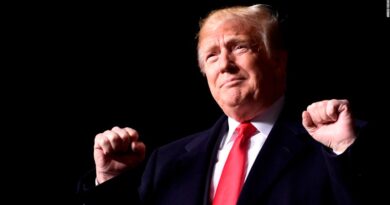WITF is connecting these lawmakers to their actions on the election-fraud lie. Here’s why

January 28, 2021 | 3:19 PM
President Donald Trump’s election-fraud lie caused many of his supporters to believe incorrectly that the election had been stolen, and it led to an assault on the U.S. Capitol, an attack that also targeted the country’s electoral process and the U.S. government itself.
WITF believes elected officials who supported the election-fraud lie through their actions should be held accountable, and we believe consistently presenting the facts that reveal the lie will play a part in diminishing its power over those who believed and supported it.
In stories on-air and online we will identify those U.S. representatives or state legislators to hold them accountable for their actions. For example:
- “(name), who voted against certifying Pennsylvania’s election results for President Biden despite no evidence to support election-fraud claims…”
- “(name), who signed a letter asking members of Congress to delay certifying Pennsylvania’s electoral votes despite no evidence that would call those results into question…”
- “(name), who supported Donald Trump’s 2020 election-fraud lie by signing a letter urging members of Congress to object to Pennsylvania’s electoral votes going to Joe Biden…”
When using this language, we’ll consider new information — for example, if a lawmaker acknowledges that no widespread fraud was found that would have affected the 2020 presidential election results. Each story will include a note about why we’re using the language, which we developed in consultation with Lynn Walsh at the Trusting News project and with NPR’s public editor Kelly McBride.
To talk about this with us, email us at news@witf.org.
Who are the legislators for whom we’ll use this language?
They are lawmakers who took at least one of three actions:
U.S. representatives who voted against certifying Pennsylvania’s electoral votes
(See why we believe this objection differs from past Democratic objections)
- John Joyce, 13th District
- Fred Keller, 12th District
- Mike Kelly, 16th District
- Dan Meuser, 9th District
- Scott Perry, 10th District
- Guy Reschenthaler, 14th District
- Glenn Thompson, 15th District
- Lloyd Smucker 11th District
U.S. representatives who signed on to Texas lawsuit
- John Joyce, 13th District
- Fred Keller, 12th District
- Mike Kelly, 16th District
- Dan Meuser, 9th District
- Scott Perry, 10th District
- Guy Reschenthaler, 14th District
- Glenn Thompson, 15th District
State lawmakers who signed letters to Congress opposing Jan. 6 electoral vote certification
The House letter asked Congress to object to certification. The Senate letter, dated Jan. 4, asked Congress to delay certification because, it said incorrectly, SCOTUS “is to hear Trump v. Boockvar in the coming days.” On Jan. 11 SCOTUS refused to fast-track the case.
The lawmakers who signed are:
- Jake Corman, Senate president pro tem, 34th District
- Kim Ward, Senate majority leader, 39th District
- Sen. Judy Ward, 3oth District
- Sen. Kristin Phillips-Hill, 28th District
- Sen. Mike Regan, 31st District
- Sen. David Argall, 29th District
- Sen. Ryan Aument, 36th District
- Sen. Doug Mastriano, 33rd District
- Sen. Joe Pittman, 41st District
- Sen. Pat Stefano, 32nd District
- Sen. Camera Bartolotta, 46th District
- Sen. Gene Yaw, 23rd District
- Sen. Bob Mensch, 24th District
- Sen. Michele Brooks, 50th District
- Sen. Scott Hutchinson, 21st District
- Sen. Wayne Langerholc, 35th District
- Sen. Mario Scavello, 40th District
- Sen. Scott Martin, 13th District
- Sen. Devlin Robinson, 37th District
- Rep. Bryan Cutler, speaker of the House, 100th District
- Rep. Kerry Benninghoff, House majority leader, 171st District
- Rep. Seth Grove, 196th District
- Rep. Kate Klunk, 169th District
- Rep. Torren Ecker, 193rd District
- Rep. Frank Ryan, 101st District
- Rep. Dan Moul, 91st District
- Rep. Dawn Keefer, 92nd District
- Rep. Mike Jones, 93rd District
- Rep. Greg Rothman, 87th District
- Rep. Barbara Gleim, 199th District
- Rep. Perry Stambaugh, (rep.-elect at the time), 86th District
- Rep. Jim Cox, 129th District
- Rep. Bud Cook, 49th District
- Rep. Tina Pickett, 110th District
- Rep. David Rowe, 85th District
- Rep. Clint Owlett, 68th District
- Rep. Ryan Warner, 52nd District
- Rep. Aaron Bernstine, 10th District
- Rep. Eric Nelson, 57th District
- Rep. Kathy Rapp, 65th District
- Rep. Doyle Heffley, 122nd District
- Rep. Lou Schmitt, 79th District
- Rep. David Maloney, 130th District
- Rep. Mark Gillen, 128th District
- Rep. Craig Staats, 145th District
- Rep. Mindy Fee, 37th District
- Rep. Jesse Topper, 78th District
- Rep. Eric Davanzo, 58th District
- Rep. Paul Schemel, 90th District
- Rep. Cris Dush, 25th District
- Rep. John Hershey, 82nd District
- Rep. David Millard, 109th District
- Rep. Brad Roae, 6th District
- Rep. Ryan Mackenzie, 134th District
- Rep. Marci Mustello, 11th District
- Rep. Lee James, 64th District
- Rep. Matt Dowling, 51st District
- Rep. George Dunbar, 56th District
- Rep. Jonathan Fritz, 111th District
- Rep. Rich Irvin, 81st District
- Rep. Martin Causer, 67th District
- Rep. Jeff Wheeland, 83rd District
- Rep. Tim Hennessey, 26th District
- Rep. David Hickernell, 98th District
- Rep. Brett Miller, 41st District
- Rep. Keith Greiner, 43rd District
- Rep. Thomas Sankey, 73rd District
- Rep. Donna Oberlander, 63rd District
- Rep. Curt Sonney, 4th District
- Rep. Mike Reese, 59th District
- Rep. Martina White, 170th District
- Rep. Carl Walker Metzgar, 69th District
- Rep. James Gregory, 80th District
- Rep. Michael Peifer, 139th District
- Rep. Steven Mentzer, 97th District
- Rep. Rob Kauffman, 89th District
Why are we doing this now, when Democrats raised objections to electoral college votes in previous years?
First, the facts:
- In 2005, a group of House Democrats objected to the counting of Ohio’s electoral votes. Democratic Sen. Barbara Boxer joined the objection, prompting debate in both chambers. The Democrats alleged “widespread irregularities” in Ohio’s election, which President George W. Bush won by 118,000 votes. Republicans cited reports by journalists showing the claims to be untrue. The objections were voted down 267-31 by the House and 74-1 by the Senate. Losing presidential candidate John Kerry did not participate in the protest. Those who objected said their intent was not to overturn the result of the election, although had the challenge succeeded, it would have done so. (Source: CNN)
- In 2017, more than a half-dozen Democrats raised objections during the certification vote. No senators joined, so the objections went nowhere and Congress certified Donald Trump as president. (Source: NPR)
Why those examples are different than in 2021
- As early as July 2020, President Trump began proclaiming that the only way he could lose his re-election bid was if the election was rigged. He said it often during his campaign. That was false.
- Around the same time, Trump began calling for election results to be final the night of the election, and if results weren’t known that night, it would indicate election fraud. That was false. Ballot-counting always continues past election night, and, because of the anticipated increase in vote-by-mail, elections offices across the country told the public that counting all the votes would take some time.
- As the election neared, Trump began focusing on experts’ predictions that he would earn more votes than Biden from Election Day voters, but that Biden would earn more votes from mail-in balloting. He decided to exploit that to convince Americans that the election had been fraudulent. In the early morning hours of Nov. 4, he gave remarks at the White House during which he lied by saying that he had won the election. That was false; votes were still being counted.
- Once news organizations called the election for Joe Biden on Nov. 7, Trump and his campaign began alleging massive voter fraud. They continued to claim that Trump had won, despite vote totals showing Biden had won. Trump’s claims of fraud were demonstrably false and failed multiple times in courts across the country.
- Trump’s election-fraud lie received support from the Republican-controlled Pennsylvania state House, including a request that a committee audit the 2020 election to ensure “the accuracy of the results” — even though no evidence had been presented to suggest results were not accurate.
- On Nov. 20, Rep. Seth Grove (R-York), held a news conference saying he wanted Dominion Voting Services to answer “accusations” about their machines, which were used in 14 Pennsylvania counties. Trump and his supporters had accused Dominion of being part of an international conspiracy and claimed its machines had flipped Trump votes to Biden votes. But Trump won 12 of the 14 counties that used Dominion machines. And the federal Cybersecurity & Infrastructure Security Agency said the election was the “most secure in American history,” adding, “There is no evidence that any voting system deleted or lost votes, changed votes, or was in any way compromised.”
- On Nov. 25 in Gettysburg, state Sen. Doug Mastriano (R-Franklin) led a meeting of the state Senate Majority Policy Committee that gave Trump lawyer Rudy Giuliani a platform to spread disinformation about the 2020 election. Trump called in to the meeting and, via a cell phone held up to a microphone, repeated the election-fraud lie to the crowd, saying, “This election was rigged, and we can’t let that happen.”
- On Dec. 4, Pennsylvania Republican House members sent a letter asking the state’s congressional delegation to dispute Pennsylvania’s legal and certified election results.
- On Dec. 11, seven Pennsylvania congressional Republicans signed on to a Texas lawsuit, filed directly to the U.S. Supreme Court, that aimed to overturn the legal results of the presidential election in Pennsylvania, Georgia, Wisconsin and Arizona. The court refused to hear the case. Two justices said the court was obligated to hear it, but would not have granted the relief it sought.
- On Dec. 28, 17 Pennsylvania House members released an analysis they said showed a discrepancy between the number of votes counted and the number of people who voted, and they said that means Pennsylvania’s election results were certified “in error.” But they had made a mistake: They used the wrong numbers for their analysis, the Department of State said, so their analysis was wrong.
- Trump’s election-fraud lie received support from Pennsylvania’s congressional representatives, including Rep. Scott Perry (R-York), who retweeted the incorrect state House-member analysis, saying it called into question the integrity of Pennsylvania’s election.
- On Jan. 4, Pennsylvania Senate Republican leaders, joined by all but seven members of the GOP caucus, signed a letter asking Congress to delay certification of Biden’s win, scheduled to take place in two days.
- On Jan. 6, eight Republican members of Pennsylvania’s congressional delegation voted against certifying the state’s legal presidential election results. The vote occurred hours after President Trump urged supporters at a rally to march on the Capitol; the mob violently assaulted the Capitol in an attempt to stop Congress from certifying Biden’s victory.
*** This article has been archived for your research. The original version from witf.org can be found here ***


